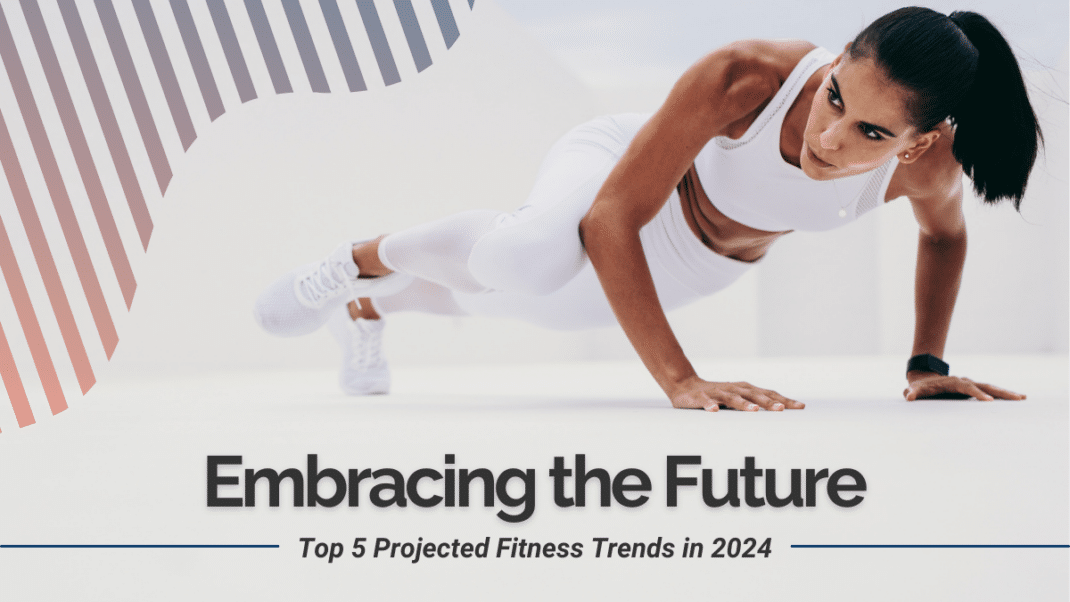Applying Neuroscience to Exercise Programming
Boosts in blood flow and neurochemicals are just a piece of the puzzle.
| Earn 1 CEC - Take Quiz
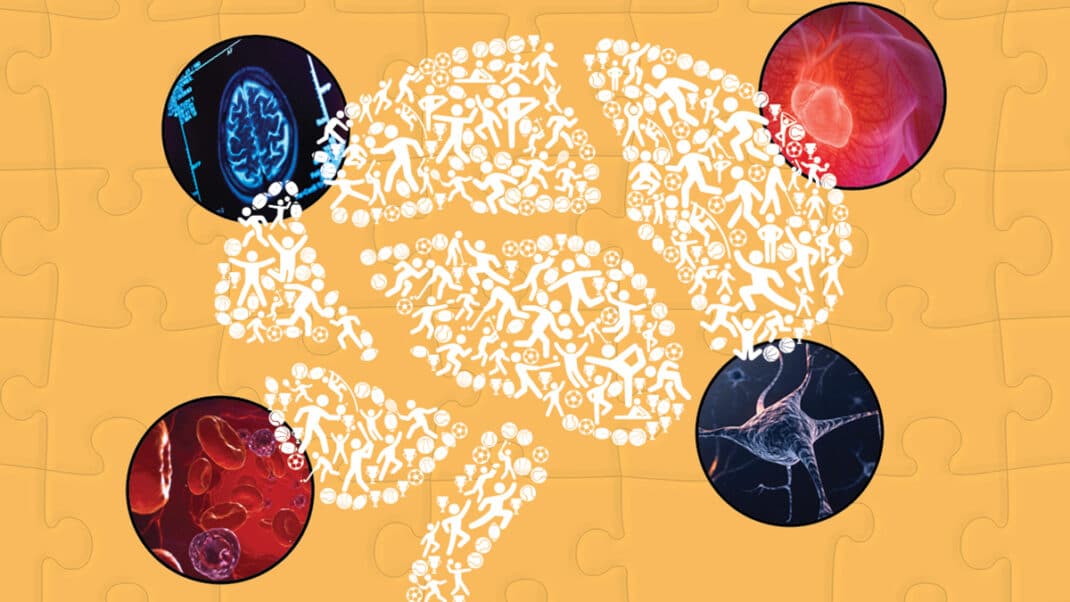
It’s common knowledge that exercise can benefit the brain in a multitude of ways—and the evidence in neuroscience supporting this idea continues to increase (Bamidis et al. 2014). Even so, many people have a view that is “mechanistically narrow or biased.” In other words, they focus on only a couple of mechanisms, such as blood flow or neurotransmitters, when something more like a complex orchestra of neurobiology is involved.
In fact, there is mounting neuroscience research showing that different modalities of exercise can provide unique benefits to the brain at various levels, from cellular to global and functional to behavioral. Ready to open your mind to the wider array of brain benefits? This article summarizes the neuroscience, shares helpful specifics and offers guidance for applying the findings to exercise programming.
Three Levels of Brain Benefits

According to Stillman et al. (2016), the effects of exercise on the brain occur at multiple levels. These levels are the micro level, the macro level and the behavioral level.
The micro level in the brain is associated with the smaller components and physiology (e.g., neurons and synapses) that make up the macro level (i.e., regional and global levels). The behavioral level refers to observable changes (e.g., in mood or cognition) expressed as the result of the changes at the micro level and the macro level (Stimpson, Davison & Javadi 2018). If the jargon is making your head spin a little, read the refresher information on brain anatomy and functions in “Memory Jogger: Parts of the Brain” and “Memory Jogger: Mental Functions,” below , before delving deeper.
Micro-Level Benefits
Using exercise physiology as a metaphor, the micro-level changes in the brain include changes at the cellular and network levels, which are akin to changes in the neuromuscular system at the motor-unit level. Micro-level changes include changes that support brain structure and function, such as blood flow and neurotransmitter activity in the brain, which is also a shared characteristic with the neuromuscular system. Specific micro-level benefits can be seen in the following areas:
Growth factors. Increases in proteins, hormones and molecules that either exist in the brain or enter via the blood-brain barrier can lead to various improvements in brain structure and brain function. Exercise improves neurotrophic factors (related to nervous tissue growth) including nerve growth factor, insulin-like growth factor 1, brain-derived neurotrophic factor and vascular endothelial growth factor. These growth factors play key roles in neuron creation, growth, survival and proliferation, as well as supportive functions (e.g., VEGF aids in the development of new blood vessels in the brain).
Blood flow. The increased cardiorespiratory demands of exercise, even at lower-intensity levels, can increase blood flow into and within the brain, delivering oxygen and nutrients more effectively and efficiently throughout.
Neurotransmitters. Neurochemicals, such as dopamine, acetylcholine and cortisol, increase during exercise, which can then lead to behavioral-level changes such as acute states of alertness and positive mood. Over the long term, certain neurotransmitter receptors can become more efficient in anticipation of the neurochemical responses to exercise.
Brain waves. As exercise is an excitatory activity, it encourages the expression of brain waves that are of faster speeds, particularly during the exercise session. Over time, exercise can lead to more efficient brain activity, even in nonexercise states (such as during sleep).
These micro-level changes in blood flow, neurotransmitters, hormone activity and brain waves often give way to larger-level functional changes at the macro level.
Macro-Level Benefits
At the macro level, regions and networks of the brain are like individual muscles and muscle groups, or kinetic chains. Exercise can cause macro-level changes to brain structure and brain function in the brain’s regions (e.g., temporal and frontal lobes), subregions (e.g., hippocampus and prefrontal cortex) and networks (e.g., central executive network and default mode network), as well as the brain as a whole (e.g., white- and gray-matter volume) (Baniqued et al. 2018; Burdette et al. 2010). Here are the primary changes at the macro level:
Brain function. Earlier exercise-related brain changes are more likely to be reflected as functional changes to certain regions, subregions or networks of the brain (Voss et al. 2010). Exercise can make the brain more efficient at utilizing energy to accomplish certain tasks. It can also improve brain function in ways that lead to beneficial behavioral-level changes in mood and cognition.
Brain structure. In addition to neuronal changes, exercise can benefit entire brain regions and the brain overall. This can include increases in the integrity of white matter (which helps transmit signals) and increases in volume of gray matter (which processes information) as well as gray matter preservation (e.g., slowing atrophy related to aging or a disease).
Behavioral-Level Benefits
Behavioral-level benefits are more easily noticeable by exercise participants and observers than are macro- or micro-level benefits. They are also more easily assessed—through questionnaires, surveys, discussions and observation. (See “Micro- and Macro-Level Assessments,” below, for how those are measured.) Behavioral-level benefits to the brain involve both cognitive and mood-related changes.
Cognition. Exercise can improve certain aspects of cognition, both acutely and chronically, depending upon the type of exercise intervention used and the population studied. This can include improvements in attention and executive functions (which help coordinate various brain functions), among others.
Mood, stress and mental health. Exercise research and neuroscience have documented increases in positive mood states, decreases in negative mood states, reductions in stress, and improvements in stress resilience. Clinically meaningful improvements in symptoms of depression, anxiety and other mental illnesses also have been recorded. Other positive effects that support mental health include increased energy, better sleep, and improved confidence and self-esteem (Mandolesi et al. 2018).
See also: Boosting the Brain Health of Older Adults
Unique Benefits of Specific Exercise Modalities

While the benefits discussed above are common to most types of exercise, neuroscience research shows that different modalities of exercise may provide unique benefits to the brain. Here are some highlights.
Resistance Training
Resistance training seems to benefit the structure and function of the frontal lobe, specifically with regard to executive functions (Herold et al. 2019; Best et al. 2015). Some researchers have posited resistance training as a form of “cognitive training” because it requires a certain level of executive functions to perform—which may also be why resistance training has been found to create improvements in these complex mental processes (Liu-Ambrose et al. 2010).
Some studies have also found resistance training to benefit certain subfields (smaller regions) of the hippocampus (Broadhouse et al. 2020). And several studies have observed the positive correlation between exercise-related neuromuscular changes (i.e., increases in muscle mass, muscle strength and neuromuscular efficiency) and brain health, especially as it relates to aging and the prevention of frailty.
The contraction of skeletal muscle tissue during this modality has been found to release a growth factor called irisin (named after Iris, Greek mythology’s messenger to the gods, which in this case is the brain). Irisin crosses the blood-brain barrier and can improve brain function (Young, Valaris & Wrann 2019).
Aerobic Exercise
Aerobic exercise seems to improve white-matter integrity, as well as volume of global gray matter, the temporal lobe and the hippocampus (Voss et al. 2013; Colcombe et al. 2006; Bugg & Head 2011; Kleemeyer et al. 2016).
This modality has also been found to contribute to frontal lobe volumes, cognition and improvements in executive functions (Hayes, Alosco & Forman 2014; Hillman, Erickson & Kramer 2008). However, researchers debate the significance of these findings, and more research needs to be done (Chen et al. 2020; Diamond & Ling 2015).
Aerobic exercise has been shown to result in structural and functional improvements in tandem: As it increases blood flow, it also increases the mobilization of brain-derived neurotrophic factor. BDNF has also been thought to contribute to neurogenesis, specifically in the hippocampus (key to learning and memory), although more human research is needed (Van Praag 2008). Aerobic exercise also promotes angiogenesis, or the creation of new blood vessels. (See “Effects of Exercise on Angiogenesis,” below.)
The acute benefits of aerobic exercise include changes in neurotransmitter levels, cerebral blood flow, excitation of brain waves and the expression of growth factors such as BDNF for 60–120 minutes after ceasing exercise. Frontal lobe–dependent cognitive functions, including executive functions, show improvements for up to 2 hours after exercise, and reduced stress and improved mood can last for 12–24 hours postworkout (Basso & Suzuki 2017).
Neuromotor Exercise
Neuromotor exercises are exercises that include a wide variety of motor skills, including balance, coordination, agility and proprioceptive training. This includes many coordinated activities that involve skill learning, such as sports, dance and martial arts (Burzynska et al. 2017; Rehfeld et al. 2018; Jacini et al. 2009). It also includes mind-body exercises like yoga and Pilates.
Because skill-building challenges the brain, neuromotor exercise can improve cognition, the volume of the hippocampus (critical to learning and memory), and the volume and function of the basal ganglia (the area of the brain affected in Parkinson’s disease) (Becker, Kutz & Voelcker-Rehage 2016; Niemann et al. 2014). It may also benefit the cerebellum (involved in balance and coordination), as well as the parietal lobe (which processes sensory information), although more research is needed on how and how significantly (Di Paola, Caltagirone & Petrosini 2013).
Neuromotor exercises include open-skill exercises, which take place in a changing environment, and closed-skill exercises, which take place in a static environment.
Open-skill exercise. Because of their unpredictability, open-skill exercises challenge the brain more and may benefit certain cognitive functions more than closed-skill types (Gu et al. 2019). As skills are learned and mastered, they become more automated, which benefits cognition and neuroplasticity (the brain’s ability to adapt and change). This provides an opportunity to introduce more novelty, complexity and/or variability to further challenge the body and brain (Pi et al. 2019; Voelcker-Rehage, Godde & Staudinger 2011; Niemann, Godde & Voelcker-Rehage 2014; Raw et al. 2019).
Mind-body exercise (MBE). MBE differs from many other types of neuromotor exercise in that it is typically less metabolically intense. It focuses on, requires and develops coordination, breathing, balance and neuromuscular efficiency. Examples include yoga, Pilates, tai chi and qigong. These MBE modalities have been found to benefit certain aspects of cognition, mood and brain structure (Gothe et al. 2019; Tao et al. 2017; Tsang & Fung 2008; Zhang et al. 2018; Wayne et al. 2014).
Multimodal Programs
Multimodal programs, which combine more than one modality of exercise together (e.g., aerobic training and resistance training), are more likely to slow or prevent cognitive decline when compared with single-mode programs (Bae et al. 2019). In addition, novelty, complexity and variability typically can be more easily built into multimodal exercise programs when compared with single modality programs (Iuliano et al. 2015; Levin, Netz & Ziv 2017). These factors may help contribute to brain health, as discussed earlier, by increasing brain activity required to accomplish new and challenging skills.
To provide the best brain benefits, exercise programs should seek to incorporate a reasonable amount of novelty and cognitively demanding and open-skill exercise modalities, either as programmed activities or leisure-time activities.
See also: Exercise and Brain Health
Guidelines on Exercise Dosage From Neuroscience
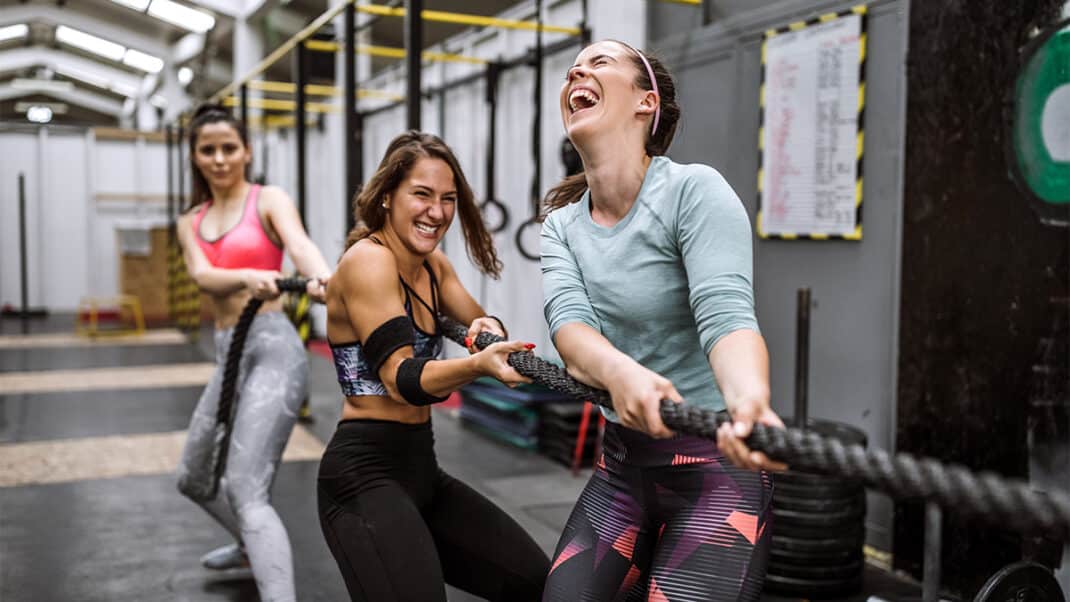
It is difficult to conclude what the “minimum viable dose” of exercise may be for certain short- and long-term brain health benefits, whether they be structural, functional or behavioral (Cabral et al. 2019).
In a systematic review of neuroscience research on older adults (with and without mild cognitive impairment and dementia), significant improvements in executive functions and processing speed were found after 52 hours of exercise (over varying time periods), regardless of the modality or modalities (Gomes-Osman et al. 2018). Many neuroscience studies have found certain brain benefits derived from shorter exercise durations, frequencies and interventions, including ones below the Physical Activity Guidelines for Americans, 2nd ed., which are explored more below (Chapman et al. 2013; Piercy et. al. 2018).
Resistance training. The Guidelines recommend resistance training 2–3 times per week for 30–60 minutes per session, with most major muscle groups targeted. Most resistance-training research focuses on using weights, bands and machines, so the brain benefits of body-weight training (BWT) are less clear. BWT interventions for brain health have been studied primarily in older, more frail populations (Chang et al. 2012). Further, many studies on resistance training do not reveal the metabolic demand of the interventions studied, so it’s unclear whether there is also an aerobic component to the improvements (Berryman et al. 2014).
Aerobic exercise. The Guidelines recommend 150–300 minutes of moderate-intensity aerobic activity, or 75–150 minutes of vigorous intensity aerobic activity (or a combination thereof). Researchers have looked at a wide array of types of aerobic exercise interventions, so there are too many variables to provide a clear answer to how much is best. The good news: Brain benefits have been found for low, moderate and high intensities, for both continuous and interval training, and at durations of 5–90 minutes (Andrews et al. 2020; Jiménez-Maldonado et al. 2018). Keep in mind that many neuromotor exercises can also be aerobically demanding, which is helpful for achieving the minimum guidelines of 150–300 minutes per week.
Neuromotor exercise. The Guidelines promote 2–3 weekly sessions of neuromotor exercise, including balance and/or mind-body exercise. Because of their ability to challenge the brain, open-skill exercises are recommended to be a part of all programs (Seidler et al. 2010). Though research has primarily observed individual modalities of open-skill exercise (e.g., dance or sports), fitness professionals can incorporate open-skill exercises into any type of aerobic, resistance and/or mobility programs (Rehfeld et al. 2018; Tsai et al. 2017). The novelty, complexity and variability can be adjusted by making changes within the modality (e.g., with a new dance routine or a new tennis opponent) or by switching between modalities (e.g., participating in tennis and dance) (Moreau, Morrison & Conway 2015). These factors can be varied similarly in mind-body exercise by trying different types (e.g., yoga versus tai chi) and by exploring variations within a modality (e.g., hatha yoga versus ashtanga).
Motivation and Adherence
As with other exercise outcome goals, brain health in itself may not be enough to spark participants to act and adhere to programming. But you can use neuroscience and the brain to benefit here, too.
Enjoyment. Enjoyment is an important factor in motivation, in general, but it may also be important for specific brain health outcomes. Exercises that produce enjoyment (a psychological component of mood) are more likely to positively impact mood—whereas exercises that are not enjoyed are less likely to do so. It’s possible that enjoyable activities are also more likely to improve cognition, although more research is needed.
Progression. Help participants become aware of how exercise makes them feel cognitively and mood-wise in the shorter term, then use sound motivational strategies to slowly increase their duration, frequency and/or variability over time until they reach their individual goals. On average, this should be done over periods of 3–6 months, although this is highly individual, and more research is needed to determine the most effective exercise promotion strategies.
Individuality. As with any exercise program, the participant’s personal circumstances and preferences play a key role in motivation and adherence. These factors include individual likes and dislikes, experience, psychology, socioeconomics, accessibility, and environment (Mortimer et al. 2012). For example, clients who live with other family members may be limited in terms of timing and exercise space, and older adults with cognitive impairments may require assistance of a spouse or hired caregiver in carrying out their program.
Physician supervision. All exercise and physical activity program changes should include physician supervision and approval, and recommended referrals to allied healthcare professionals will help maintain long-term adherence while also achieving optimal brain health.
See also: Effects of Aging on the Neuromuscular System
Putting Neuroscience Research Into Practice for Exercise
Much of the neuroscience research on exercise and brain health cited in this article involved healthy adult participants and older adults (Vecchio et al. 2018; Etnier, Drollette & Stutsky 2019). As such, it may not be perfectly translatable to other populations. However, neuroscience research on special populations has shown that many of these exercise modalities (individually and in combination) lead to brain benefits. Some such populations studied include children, people with cognitive impairments and neurological conditions, and those in rehabilitation programs (Coetsee & Terblanche 2017; Chaddock, Voss & Kramer 2012; van Uffelen et al. 2008; Zhou et al. 2020). Therefore, it stands to reason that physical activity can benefit most people’s brains in multiple positive ways. Provided you cater to each client’s individual abilities and needs, which is part and parcel of being a multifaceted fitness professional, weaving brain-oriented movement into your programs seems to be a smart move across the board.
Open-Skill Versus Closed-Skill Exercises
Open-skill exercise is more effective than closed-skill exercise for improving some aspects of cognitive function. The variability and challenges of open-skill exercise fosters neuroplasticity and adaptations.
Open-Skill Exercise
- Environment is constantly changing.
- Movements must be continually adapted.
- Pacing is predominantly externally determined.
Closed-Skill Exercise
- Environment is stable and predictable.
- Movements have a clear path, beginning and end.
- Pacing is determined by the participant.
Different Modalities, Different Perks
See which types of workouts cause certain parts of the brain to light up—and the key benefits they provide.
Memory Jogger: Parts of the Brain
You already have a strong knowledge of anatomy and its key terms, which you use on a daily basis. To have a deeper discussion of exercise’s benefits on the brain, specifically, it helps to know some key terms related to neuroscience and neuroanatomy, as well. Here’s a quick refresher on the components of the brain and the structure and function of each.
Brain Structures
The brain is composed of two hemispheres (left and right halves), each with different parts called lobes. Each lobe has a distinct name, function and substructures within it. For example, the temporal lobe contains the hippocampus, an area of the brain critical for learning and memory, and the frontal lobe. The frontal lobe contains the prefrontal cortex (PFC), which plays a role in executive functions such as decision-making and goal-setting, among others. These lobes are part of the cerebrum, which is the largest part of the brain. The cerebellum, or “little brain,” sits below the cerebrum and controls balance, movement and coordination.
Brain Networks
Brain networks refer to functional connections among the various lobes and cortices of the brain. They include the default mode network (the task-negative or “mind-wandering” network) and the central executive network (the task-positive network). Other networks include the sensorimotor network, the salience network, the visual system and the limbic system.
Brain Cells
Brain cells are called neurons. When new neurons are created, this process is called neurogenesis. The branches that extend from the neurons to gather incoming information are called dendrites.
Synapses and Neurotransmitters
The connections between neurons are referred to as synapses, which allow for communication among neurons. The creation of new synapses is known as synaptogenesis. Chemicals called neurotransmitters help transfer messages between synapses. These can be inhibitory (blocking or preventing communications), such as epinephrine, or excitatory (triggering or firing off communications), such as serotonin.
Memory Jogger: Mental Functions
Cognition refers to a set of mental functions that allow one’s interaction with the world internally and externally. Specialized sets of cognition skills include the following, which have different subcategories and functions therein.
Attention. Attention refers to recognition of stimuli in the environment via the senses and the information that’s gathered from them (aka “attended”) by the brain. Attention can be sustained (focused for a longer period of time), selective (filtering out irrelevant stimuli to focus on target stimuli), switched (also called “task-switching,” or switching focus among different stimuli), or divided (paying attention to more than one stream of stimuli at once).
Processing speed. This refers to how quickly certain cognitive functions occur. Processing speed can be specific to certain senses (such as visual or auditory) and can be influenced by the complexity and novelty of tasks (with trickier tasks taking more time to process). Processing speed can take longer if a task is “top-down” (more complex) or quicker if it is “bottom-up” (more simple and reactive).
Executive functions. This set of higher-level cognitive skills influence and coordinate other cognitive abilities, which is why they are often referred to as the “CEO of the brain.” They include impulse control, working memory, cognitive flexibility and a host of other subfunctions such as planning, reasoning and multitasking.
Memory. Memory encompasses the encoding, storage and retrieval of information. There are many types of memory, including episodic (events and experiences), semantic (facts, figures and knowledge), and procedural (related to learned processes, such as walking).
Micro-Level Changes: A Timeline
Exercise modifies neurons, synapses and networks over various timepoints in both functional and structural ways. This ability to adapt and change is known as neuroplasticity. 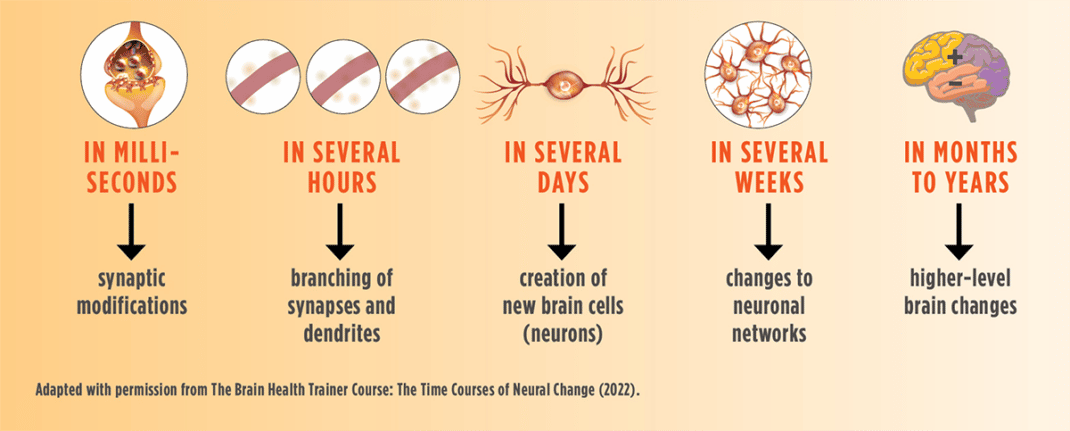
Effects of Aerobic Exercise on Angiogenesis
Aerobic exercise helps start a positive chain reaction that helps the brain in whole and in part. It stimulates blood flow to and within the brain, leading to increased capillary density, blood vessel creation and connectivity in the vascular network—aka angiogenesis. This, in turn, facilitates neurogenesis and, thus, learning and memory. 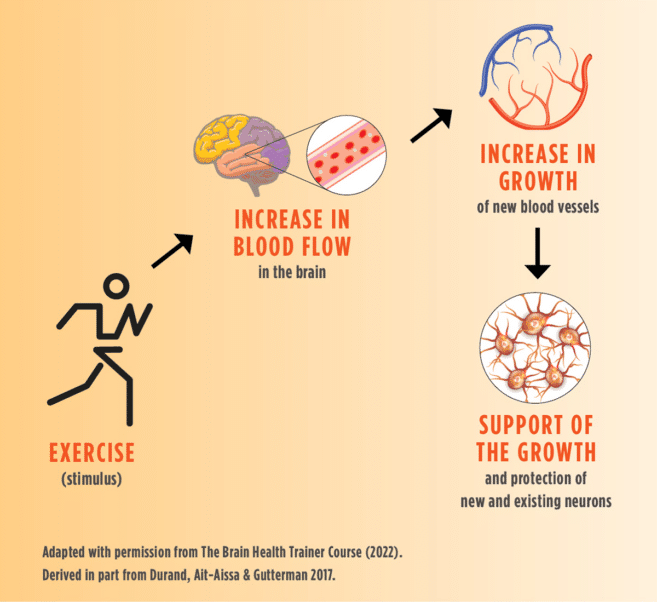
Micro- and Macro-Level Assessments
While behavioral-level brain changes can be observed or assessed more easily by participants and anyone observing them, micro- and macro-level brain changes require more complicated methods. Neurologists and researchers may use neuroimaging techniques like magnetic resonance imaging (which uses a magnet and radio waves to create images) and other methods:
Volumetric MRIs can assesses the volume of the brain as a whole, as well as the volume of individual regions and subregions. Researchers then compare measured volumes to normative data based on age and sex.
Quantitative electroencephalograms (qEEGs) measure brain wave patterns and are used in both research and clinical settings.
Functional MRIs can assess electrical and functional changes in certain brain regions. This can include assessing a brain region’s “occupancy rate,” which is how well that region of the brain functions regardless of its change in size or volume.
References
Andrews, S.C., et al. 2020. Intensity matters: High-intensity interval exercise enhances motor cortex plasticity more than moderate exercise. Cerebral Cortex, 30 (1), 101–12.
Bae, S., et al. 2019. The effect of a multicomponent intervention to promote community activity on cognitive function in older adults with mild cognitive impairment: A randomized controlled trial. Complementary Therapies in Medicine, 42, 164–69.
Bamidis, P.D., et al. 2014. A review of physical and cognitive interventions in aging. Neuroscience & Biobehavioral Reviews, 44, 206–20.
Baniqued, P.L., et al. 2018. Brain network modularity predicts exercise-related executive function gains in older adults. Frontiers in Aging Neuroscience, 9 (426).
Basso, J.C., & Suzuki, W.A. 2017. The effects of acute exercise on mood, cognition, neurophysiology, and neurochemical pathways: A review. Brain Plasticity, 2 (2), 127–52:
Becker, L., Kutz, D.F., & Voelcker-Rehage, C. 2016. Exercise-induced changes in basal ganglia volume and their relation to cognitive performance. Journal of Neurology & Neuromedicine, 1 (5), 16–24.
Berryman, N., et al. 2014. Multiple roads lead to Rome: Combined high-intensity aerobic and strength training vs. gross motor activities leads to equivalent improvement in executive functions in a cohort of healthy older adults. Age, 36 (5), 1–19.
Best, J.R., et al. 2015. Long-term effects of resistance exercise training on cognition and brain volume in older women: Results from a randomized controlled trial. Journal of the International Neuropsychological Society, 21 (10), 745–56.
Broadhouse, K.M., et al. 2020. Hippocampal plasticity underpins long-term cognitive gains from resistance exercise in MCI. NeuroImage: Clinical, 25 (102182).
Bugg, J.M., & Head, D. 2011. Exercise moderates age-related atrophy of the medial temporal lobe. Neurobiology of Aging, 32 (3), 506–14.
Burdette, J.H., et al. 2010. Using network science to evaluate exercise-associated brain changes in older adults. Frontiers in Aging Neuroscience, 2 (23).
Burzynska, A.Z., et al. 2017. The dancing brain: Structural and functional signatures of expert dance training. Frontiers in Human Neuroscience, 11, (566).
Cabral, D.F., et al. 2019. Exercise for brain health: An investigation into the underlying mechanisms guided by dose. Neurotherapeutics, 16 (3), 580–99.
Chaddock, L., Voss, M.W., & Kramer, A.F. 2012. Physical activity and fitness effects on cognition and brain health in children and older adults. Kinesiology Review, 1 (1), 37–45.
Chang, Y-K., et al. 2012. Effect of resistance-exercise training on cognitive function in healthy older adults: A review. Journal of Aging and Physical Activity, 20 (4), 497–517.
Chapman, S.B., et al. 2013. Shorter term aerobic exercise improves brain, cognition, and cardiovascular fitness in aging. Frontiers in Aging Neuroscience, 5 (75).
Chen, F-T., et al. 2020. Effects of exercise training interventions on executive function in older adults: A systematic review and meta-analysis. Sports Medicine, 50 (8), 1451–67.
Coetsee, C., & Terblanche, E. 2017. The effect of three different exercise training modalities on cognitive and physical function in a healthy older population. European Review of Aging and Physical Activity, 14 (13), 1–10.
Colcombe, S.J., et al. 2006. Aerobic exercise training increases brain volume in aging humans. The Journals of Gerontology Series A, 61 (11), 1166–70.
Diamond, A., & Ling, D.S. 2016. Conclusions about interventions, programs, and approaches for improving executive functions that appear justified and those that, despite much hype, do not. Developmental Cognitive Neuroscience, 18, 34–48.
Di Paola, M., Caltagirone, C., & Petrosini, L. 2013. Prolonged rock climbing activity induces structural changes in cerebellum and parietal lobe. Human Brain Mapping, 34 (10), 2707–14.
Durand, M.J., Ait-Aissa, K., & Gutterman, D.D. 2017. Regenerative angiogenesis: Quality over quantity. Circulation Research, 120 (9), 1379–80.
Etnier, J.L., Drollette, E.S., & Slutsky, A.B. 2019. Physical activity and cognition: A narrative review of the evidence for older adults. Psychology of Sport and Exercise, 42, 156–66.
Gomes-Osman, J., et al. 2018. Exercise for cognitive brain health in aging: A systematic review for an evaluation of dose. Neurology: Clinical Practice, 8 (3), 257–65.
Gothe, N.P., et al. 2019. Yoga effects on brain health: A systematic review of the current literature. Brain Plasticity, 5 (1), 105–22.
Gu, Q., et al. 2019. Effects of open versus closed skill exercise on cognitive function: A systematic review. Frontiers in Psychology, 10 (1707).
Hayes, S.M., Alosco, M.L., & Forman, D.E. 2014. The effects of aerobic exercise on cognitive and neural decline in aging and cardiovascular disease. Current Geriatrics Reports, 3 (4), 282–90.
Herold, F., et al. 2019. Functional and/or structural brain changes in response to resistance exercises and resistance training lead to cognitive improvements–a systematic review. European Review of Aging and Physical Activity, 16 (10), 1–33.
Hillman, C.H., Erickson, K.I., & Kramer, A.F. 2008. Be smart, exercise your heart: Exercise effects on brain and cognition. Nature Reviews Neuroscience, 9 (1), 58–65.
Iuliano, E., et al. 2015. Effects of different types of physical activity on the cognitive functions and attention in older people: A randomized controlled study. Experimental Gerontology, 70, 105–10.
Jacini, W.F.S., et al. 2009. Can exercise shape your brain? Cortical differences associated with judo practice. Journal of Science and Medicine in Sport, 12 (6), 688–90.
Jiménez-Maldonado, A., et al. 2018. The impact of high-intensity interval training on brain derived neurotrophic factor in brain: A mini-review. Frontiers in Neuroscience, 12 (839).
Kleemeyer, M.M., et al. 2016. Changes in fitness are associated with changes in hippocampal microstructure and hippocampal volume among older adults. Neuroimage, 131, 155–61.
Levin, O., Netz, Y., & Ziv, G. 2017. The beneficial effects of different types of exercise interventions on motor and cognitive functions in older age: A systematic review. European Review of Aging and Physical Activity, 14 (1), 1–23.
Liu-Ambrose, T., et al. 2010. Resistance training and executive functions: A 12-month randomized controlled trial. Archives of Internal Medicine, 170 (2), 170–78.
Mandolesi, L., et al. 2018. Effects of physical exercise on cognitive functioning and wellbeing: Biological and psychological benefits. Frontiers in Psychology, 9 (509).
Moreau, D., Morrison, A.B., & Conway, A.R.A. 2015. An ecological approach to cognitive enhancement: Complex motor training. Acta Psychologica, 157, 44–55.
Mortimer, J.A., et al. 2012. Changes in brain volume and cognition in a randomized trial of exercise and social interaction in a community-based sample of non-demented Chinese elders. Journal of Alzheimer’s Disease, 30 (4), 757–66.
Niemann, C., et al. 2014. Exercise-induced changes in basal ganglia volume and cognition in older adults. Neuroscience, 281, 147–63.
Niemann, C., Godde, B., & Voelcker-Rehage, C. 2014. Not only cardiovascular, but also coordinative exercise increases hippocampal volume in older adults. Frontiers in Aging Neuroscience, 6 (170).
Pi, Y-L., et al. 2019. Motor skill learning induces brain network plasticity: A diffusion-tensor imaging study. PLOS ONE, 14 (2), e0210015.
Piercy, K.L., et al. 2018. The Physical Activity Guidelines for Americans. JAMA, 320 (19), 2020–28.
Raw, R.K., et al. 2019. Skill acquisition as a function of age, hand and task difficulty: Interactions between cognition and action. PLOS ONE, 14 (2), e0211706.
Rehfeld, K., et al. 2018. Dance training is superior to repetitive physical exercise in inducing brain plasticity in the elderly. PLOS ONE, 13 (7), e0196636.
Seidler, R.D., et al. 2010. Motor control and aging: Links to age-related brain structural, functional, and biochemical effects. Neuroscience & Biobehavioral Reviews, 34 (5), 721–33.
Stillman, C.M., et al. 2016. Mediators of physical activity on neurocognitive function: A review at multiple levels of analysis. Frontiers in Human Neuroscience, 10 (626).
Stimpson, N.J., Davison, G., & Javadi, A-H. 2018. Joggin’ the noggin: Towards a physiological understanding of exercise-induced cognitive benefits. Neuroscience & Biobehavioral Reviews, 88, 177–86.
Tao, J., et al. 2017. Tai chi chuan and Baduanjin increase grey matter volume in older adults: A brain imaging study. Journal of Alzheimer’s Disease, 60 (2), 389–400.
Tsai, C-L., et al. 2017. Open-and closed-skill exercise interventions produce different neurocognitive effects on executive functions in the elderly: A 6-month randomized, controlled trial. Frontiers in Aging Neuroscience, 9 (294).
Tsang, H.W.H., & Fung, K.M.T. 2008. A review on neurobiological and psychological mechanisms underlying the anti-depressive effect of qigong exercise. Journal of Health Psychology, 13 (7), 857–63.
Van Praag, H. 2008. Neurogenesis and exercise: Past and future directions. Neuromolecular Medicine, 10 (2), 128–40.
van Uffelen, J.G.Z., et al. 2008. The effects of exercise on cognition in older adults with and without cognitive decline: A systematic review. Clinical Journal of Sport Medicine, 18 (6), 486–500.
Vecchio, L.M., et al. 2018. The neuroprotective effects of exercise: Maintaining a healthy brain throughout aging. Brain Plasticity, 4 (1), 17–52.
Voelcker-Rehage, C., Godde, B., & Staudinger, U.M. 2011. Cardiovascular and coordination training differentially improve cognitive performance and neural processing in older adults. Frontiers in Human Neuroscience, 5 (26).
Voss, M.W., et al. 2010. Plasticity of brain networks in a randomized intervention trial of exercise training in older adults. Frontiers in Aging Neuroscience, 2 (32).
Voss, M.W., et al. 2013. The influence of aerobic fitness on cerebral white matter integrity and cognitive function in older adults: Results of a one-year exercise intervention. Human Brain Mapping, 34 (11), 2972–85.
Wayne, P.M., et al. 2014. Effect of tai chi on cognitive performance in older adults: Systematic review and meta-analysis. Journal of the American Geriatrics Society, 62 (1), 25–39.
Young, M.F., Valaris, S., & Wrann, C.D. 2019. A role for FNDC5/irisin in the beneficial effects of exercise on the brain and in neurodegenerative diseases. Progress in Cardiovascular Diseases, 62 (2), 172–78.
Zhang, Y., et al. 2018. The effects of mind-body exercise on cognitive performance in elderly: A systematic review and meta-analysis. International Journal of Environmental Research and Public Health, 15 (12), 2791.
Zhou, X.L., et al. 2020. Effects of exercise interventions for specific cognitive domains in old adults with mild cognitive impairment. Medicine, 99 (31).
Ryan Glatt, MS
Ryan Glatt, MS, is a personal trainer and brain-health coach with over a decade of experience. He currently practices brain-based strategies for cognitive enhancement at the Pacific Brain Health Center in Santa Monica, California, in both clinical and research settings. Ryan constantly seeks to learn about health neuroscience research and practical strategies in health coaching and personal training contexts and has pursued education from the Amen Clinics, the BrainFirst Training Institute, the Neuroscience Academy and the Academy for Brain Health and Performance. He has completed the Master's of Applied Neuroscience program at King's College of London and is a National Board Certified Health & Wellness Coach.



